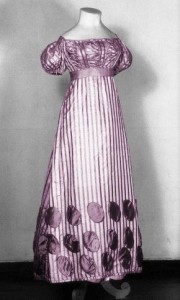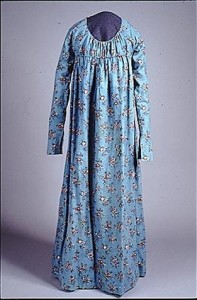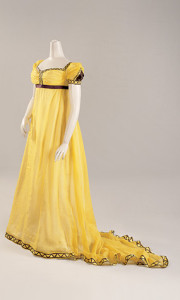For my first guest post here, I want to talk about the common impression that the Regency period was a sea of plain white gowns (another “inspired by Twitter” post from me). Yes, white was fashionable during the Regency, but it was hardly the only color worn. There was a big kick for all things ancient during the Regency, and as the statues from Rome and Greece had all lost their paint (yes, they weren’t plain white when they were new!) the period conception of the costumes of that period was white. So from the late 18th century into the early decades of the 19th, white ruled the fashionable set (not only was it all the rage, but because it was hard to keep clean, it functioned almost like an in-built sumptuary law: the poor could not ape you).
But even during that period, white was not the only color worn (though I’d lay money it was the most common color worn when sitting for a portrait, which adds to the overemphasis it seems to have on our minds today). When you look at extant garments from the period, what appears is a sea of color: Puce, orange, silvery grey, red, yellow, blue, purple, pink, stripes and block-printed and roller-printed fabrics in all sorts of patterns and colors (with improved patterning and vibrancy by the 1820s).
And while many of the examples look plain compared to the huge amounts of decorative passementarie used both before and afterward, if you look at the garments, they often have quite a few decorative elements (and would have often had more once accessorized in a period manner). If you look at the examples in Ackerman’s, you’ll see gowns of every color imaginable, and with enormous decorative variety: net overlays, lace, eyelash or fly trim, beading, spangles, tassels, Elizabethan collars/ruffs, elaborately pleated and tucked chemisettes, silk embroidery, chenille embroidery, and then we hit 1811-1815 and everything goes à la militaire or à la hussar and there’s just BRAID everywhere. By the time we get into the 1820s and the gowns have moved away from the flowing, Grecian lines into belled skirts and natural waists, the ornamentation goes wild. There are stuffed hems, and ribbon embroidery, and chenille ball trim, and rows and rows of big honking decorative stuff all around the hems.
I highly recommend Fashions in the Era of Jane Austen (it’s fashion plates from Ackermann’s c. 1809-1820) to anyone who wants to see just how spoogy the gowns can be. Or you can find select examples (in all their colorful glory) on Candice Hern’s site.
When you picture ball scenes when you’re reading, is it an all white scene, or a colorful swirl?






Thank you for all those delicious examples of coloured dresses! I suspect that (apart from the portraits) one reason people think that there was a preponderance of white dresses is because Georgette Heyer says in several books that white was the colour for girls just coming out, or at most pale pastels, and this has been picked up on and repeated by others writing Regencies.
So there is a tendency to people the imaginary ballroom with a sea of white or pale pink or blue dresses, with maybe the chaperones sitting round the edges wearing stronger colours. But even if GH was right, the young married women would also have been dancing in dresses such as those you’ve shown – so from now on I shall picture the scene as rather less monochrome than I used to!
I’m sure there was a lot of white, too. But COLOR was clearly something they loved. Heyer may well have been right about young girls wearing white/pale colors (or that could be a Victorianism that leaked over; I find a lot of the social mores in her books more Victorian/Edwardian than Georgian).
Thank you for the photos! I had the young ladies (“virgins”) in white and pale, but being rather into colors, I use some pretty vibrant colors in my mind.
Especially for waltzes. What really surprised me was the prints…
I’m going to do a post on prints, too. So many great prints from the era.
Isobel, thanks for this great contribution to help combat the misconception of the “sea of white dresses”!! Maybe someday that idea will die out entirely. 🙂 Not only was white not the only color in fashion, but anyone who looks through Ackermann’s fashion news will note that different shades were “in” in different years, much like today. As one who looks horrible in white, I always imagined the challenge for young Regency ladies with similar skin tone, and mercifully allow my characters to dress in colors as appropriate. And HJ makes a great point about how many ladies in a ballroom might be young married women! We must carry on the fight. Bravo!
I love when Ackerman’s lists what colors are “in” this season. The names alone are a kick!
These photos are…well, delicious.
Not Regency but Gilded Age–and closer to home for me–the Gilded Age New York exhibit sponsored by Tiffany & Co at the Museum of the City of New York has two Worth gowns in pristine condition. ((Drool))
http://www.mcny.org/content/gilded-new-york
Have you seen Cathy Hay’s Worth gown reproductions? She’s amazing. She’s been working on the Peacock Dress for a couple of years now.
http://peacockdress.livejournal.com/414260.html
Thanks for sharing this, Isobel! The way I’ve pictured it, younger ladies in their first season wore white or pale colors but after that and especially once they married, they might wear brighter or darker colors.
I really love these images. I crave that first dress; green is a color that looks much better on me than white!
Your computer must show a different shade than mine. It looks puce on mine (sort of dull purple-brown). I have a lot of puce dresses in the image cache, too).
Wonderful article – and I love the photos you’ve provided. Those dresses are simply gorgeous.
Fabulous information and pictures as usual, Isobel ! I have always wondered if a young lady wanted to be shown at her best advantage why in God’s name would she wear white unless she was one of the few for whom white (and other pale colors) would be considered becoming.
For me any of the dresses you’ve shown here would be appropriate for a young lady to wear, with the exception perhaps of the red one.
I’m thinking about doing a Lady in Red post. I have a LOT of red dresses in my image cache.
Oh please do! I would love to see those images. A lady in red is always more fun to write about !
And I have always imagined the Regency ballrooms in my stories to be glorious spiraling canvases of color.
Me too! But I think my inner-eye mostly sees all my parents’ friends dressed and dancing, and few of them chose white.
Great guest post-I loved all the pictures of the gowns warn, and am going to check out the book you rec’d.
It’s a good book, even if the images are low res. I *REALLY* wish she’d done it properly and done high resolution scans.
They are so pretty! Thanks, Isobel!
A colorful swirl
I like the purple striped gown!
Love the colors, Isobel.
And I love the gowns of the 1820s too, as there were even more gorgeous colored and printed gowns being worn.
I’ll be doing a post on those in the upcoming weeks!
Wonderfully informative post, Isobel! I’m bookmarking it. These dresses are gorgeous!!
It was my understanding that debutantes had to wear white gowns throughout their year, or season. But I imagine many colors in the dress of the day. People also think all houses were white then as well – if they were painted, which not all were, they were often in color.
As far as I know, there is no “rule” about debutantes wearing white. It was simply a fashionable color and one that appealed because it was demure and virginal. But any soft color would also have fit the bill (lots of pale blue, pink, yellow, purple, green gowns out there and lots of paintings of unmarried girls wearing colorful gowns).
I did a quick search in Ackerman’s, and there are no references in any of the fashion plate descriptions to anything being suitable/appropriate (or inappropriate) for girls in their first season. If there was a social “rule” for girls wearing white, I would expect that to crop up somewhere in those.
[…] The Colorful Regency […]
[…] post is going to be more of a gallery. I want to build on my last post (The Colorful Regency) and highlight print gowns. The two methods of printing were block and roller (which are exactly […]